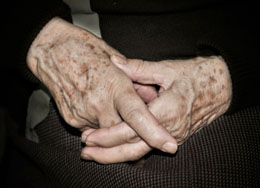Symptoms of psoriatic arthritis usually develop years after the onset of this skin condition. The symptoms may vary and can be gradual and subtle in some cases; and sudden and dramatic for others. The following Buzzle article provides information about the various symptoms and treatment options available for this variation of arthritis.

Psoriasis is a chronic skin condition wherein the affected person develops raised, red patches and scaly skin. Arthritis is an inflammatory disease of the joints, in which the joints swell and the individual experiences joint pain. Psoriatic arthritis (PA)is a type of aggressive and potentially destructive inflammatory arthritis. This condition develops in approximately 10% patients affected by psoriasis.
Causes
Apparently, there are no known causes of this condition. However, there is a theory that genes may play a role in development of this medical condition. It may result from a combination of genetic, immune, and environmental factors. Also, it has been observed that 40% of the people with psoriasis or psoriatic arthritis have a close relative who has been affected by this condition.
Symptoms
This condition is classified into 5 types, with each type being characterized by a different set of symptoms. It is important to identify the type for proper treatment.
Asymmetrical arthritis: It targets two or three joints typically. It doesn't affect the joints in pairs on the opposite side of the body. It commonly affects the knee, hip, or the fingers and toes.
Psoriatic Spondyloarthritis: It affects the spine and causes stiffness or inflammation in the spine. In some cases, it can also affect the connective tissues, such as ligaments. It is a serious condition, and its symptoms include deformity and change in posture. It affects around 5% of people affected with psoriasis.
Symmetric PA: It affects the same joints in multiple pairs, on the opposite side of the body. It causes pain in the bones and joints located throughout the body. The pain and discomfort is severe and mostly women suffer from this condition. Here the psoriasis-related skin symptoms are very prominent and joint deformity may also occur in a few cases.
Distal Interphalangeal Predominant PA: It affects the joints at the end of fingers and toes. It may also cause inflammation of skin at the edge of the nail. The symptoms include pain, swelling, and overall discomfort. It affects 5 - 10% of the people affected by PA, which are mostly men.
Arthritis mutilans: It involves the destruction of smaller bones in the hands, feet, and other areas of the body. It affects 16% of the people affected by PA, and can be severe.
In general, the symptoms include fatigue, joint pain, bone and joint degeneration, and reduced range of movement. Also pitted or thickened nails, flaking silver patches of skin with red inflamed skin underneath, and sore eyes are a few other symptoms. Getting the right treatment early is important to prevent joint destruction and disability.
Treatment
The main goal of the treatment is control the inflammation, prevent joint damage, and increase joint mobility. Application of ice or heat, relaxation of the joints, exercises to strengthen the muscle, and electropathy are some of the treatment options available to relieve the symptoms. Further, you can even use a splint on the affected part in case of severe flare-ups. Drug therapy involving the use of painkillers and NSAIDs, and surgery can be considered in extreme cases.
Overall, a healthy lifestyle at the end of the day will help alleviate the symptoms. Also, daily exercise is important to keep the swelling to a minimum.
Disclaimer:
This Buzzle article is for informative purposes only, and should not be used as a replacement for expert medical advice.


 Psoriasis is a chronic skin condition wherein the affected person develops raised, red patches and scaly skin. Arthritis is an inflammatory disease of the joints, in which the joints swell and the individual experiences joint pain. Psoriatic arthritis (PA)is a type of aggressive and potentially destructive inflammatory arthritis. This condition develops in approximately 10% patients affected by psoriasis.
Psoriasis is a chronic skin condition wherein the affected person develops raised, red patches and scaly skin. Arthritis is an inflammatory disease of the joints, in which the joints swell and the individual experiences joint pain. Psoriatic arthritis (PA)is a type of aggressive and potentially destructive inflammatory arthritis. This condition develops in approximately 10% patients affected by psoriasis.